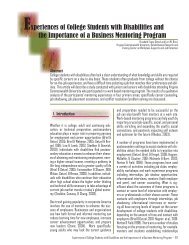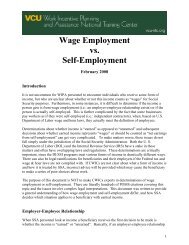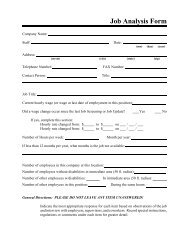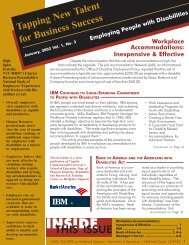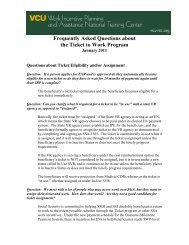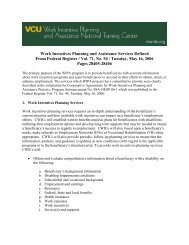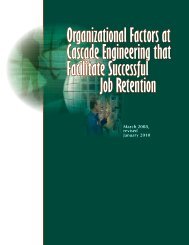Supporting adults with autism spectrum disorders in the ... - IOS Press
Supporting adults with autism spectrum disorders in the ... - IOS Press
Supporting adults with autism spectrum disorders in the ... - IOS Press
Create successful ePaper yourself
Turn your PDF publications into a flip-book with our unique Google optimized e-Paper software.
Journal of Vocational Rehabilitation 32 (2010) 109–115DOI:10.3233/JVR-2010-0500<strong>IOS</strong> <strong>Press</strong>109Positive behavior support: <strong>Support<strong>in</strong>g</strong><strong>adults</strong> <strong>with</strong> <strong>autism</strong> <strong>spectrum</strong> <strong>disorders</strong><strong>in</strong> <strong>the</strong> workplaceCarol M. SchallVirg<strong>in</strong>ia Commonwealth University, Virg<strong>in</strong>ia Autism Resource Center, P.O. Box 843020, Richmond,VA 23284-3020, USAE-mail: cmschall@vcu.eduAbstract. Individuals <strong>with</strong> <strong>autism</strong> <strong>spectrum</strong> <strong>disorders</strong> (ASD) can present challeng<strong>in</strong>g behavior at work. In fact, it is likely that<strong>the</strong> presence of challeng<strong>in</strong>g behavior can act as a major barrier for <strong>in</strong>dividuals <strong>with</strong> ASD achiev<strong>in</strong>g competitive employment.Community-based work environments can present challenges <strong>in</strong> <strong>the</strong> implementation of behavior <strong>in</strong>tervention plans. Positivebehavior support (PBS) is a behavior <strong>in</strong>tervention model that presents opportunities to implement socially valid behavior <strong>in</strong>terventions<strong>in</strong> supported and competitive workplaces. This article describes <strong>the</strong> PBS model and provides a case example for an<strong>in</strong>dividual <strong>with</strong> ASD at work. F<strong>in</strong>ally this article presents recommendations for future research <strong>in</strong> support<strong>in</strong>g <strong>in</strong>dividuals <strong>with</strong>ASD at work.Keywords: Autism, <strong>autism</strong> <strong>spectrum</strong> disorder, positive behavior support1. Introduction‘DJ’ is a 25 year old man <strong>with</strong> <strong>autism</strong>. He has beenwork<strong>in</strong>g at a small coffee and sandwich shop for about6 months. His job, like all of <strong>the</strong> jobs at this small bus<strong>in</strong>ess,is carved from <strong>the</strong> many tasks that need to beaccomplished <strong>in</strong> a work day. His tasks <strong>in</strong>clude foodpreparation, clean<strong>in</strong>g <strong>the</strong> food prep area, clean<strong>in</strong>g <strong>the</strong>d<strong>in</strong><strong>in</strong>g area, tak<strong>in</strong>g out <strong>the</strong> garbage, and stock<strong>in</strong>g <strong>the</strong>dr<strong>in</strong>k case. He has been quite successful <strong>in</strong> many aspectsof <strong>the</strong> job. He has learned to chop and slice a number ofvegetables based on <strong>the</strong>ir use. He knows <strong>the</strong> differencebetween <strong>the</strong> sizes of ‘diced’, ‘sliced’, and ‘chopped forsalad’ foods. He is <strong>in</strong>dependent on all vegetable andmeat preparation. He requires prompt<strong>in</strong>g and correctionwhen tak<strong>in</strong>g out <strong>the</strong> garbage. This is because hewants to take out <strong>the</strong> garbage whenever he checks <strong>the</strong>receptacles. In this small bus<strong>in</strong>ess, tak<strong>in</strong>g out half emptygarbage bags is too expensive. Despite this one need forcont<strong>in</strong>ued <strong>in</strong>struction, he is a success at <strong>the</strong> job. That isexcept for his behavior. His problem behavior is a majorbarrier to his be<strong>in</strong>g fully <strong>in</strong>dependent at work. He makesnoises that are disturb<strong>in</strong>g to <strong>the</strong> clientele. He does notgenerally use words to communicate. Instead he useshis behavior to let o<strong>the</strong>rs know when he is upset. At<strong>the</strong>se times, he gets louder and pushes o<strong>the</strong>rs out of hisway. This is scary to customers and staff alike. Thesechallenges occur <strong>in</strong>frequently, yet his job coach, Sam, isworried about how to beg<strong>in</strong> to fade from <strong>the</strong> site so thatDJ will be <strong>in</strong>dependent. At <strong>the</strong> same time, DJ is at riskof los<strong>in</strong>g his job if his <strong>in</strong>frequent behavior challenges<strong>in</strong>crease <strong>in</strong> frequency or <strong>in</strong>tensity.2. Individuals <strong>with</strong> ASD at work:Characteristics and supportsDJ’s story is a typical one for <strong>in</strong>dividuals <strong>with</strong> ASD[5, 9, 15, 17, 26, 43, 45, 50]. In fact, despite good jobtra<strong>in</strong><strong>in</strong>g, attention to detail, a high degree of accuracy,and a dedication to work, people <strong>with</strong> ASD are frequentlyunderemployed and serially unemployed [10,21, 27, 43, 44]. Like DJ, many <strong>in</strong>dividuals <strong>with</strong> ASDpresent a divergent employment profile. That is, <strong>the</strong>yare frequently rated as excellent employees when con-1052-2263/10/$27.50 © 2010 – <strong>IOS</strong> <strong>Press</strong> and <strong>the</strong> authors. All rights reserved
110 C.M. Schall / PBS: <strong>Support<strong>in</strong>g</strong> <strong>adults</strong> <strong>with</strong> ASD <strong>in</strong> <strong>the</strong> workplacesider<strong>in</strong>g <strong>the</strong> skill <strong>with</strong> which <strong>the</strong>y complete <strong>the</strong>ir joband difficult employees when consider<strong>in</strong>g <strong>the</strong>ir ‘people’skills and behavior challenges [16, 25, 40, 44].This f<strong>in</strong>d<strong>in</strong>g is directly related to <strong>the</strong> characteristics of<strong>in</strong>dividuals <strong>with</strong> ASD. The symptoms most associated<strong>with</strong> ASD <strong>in</strong>clude impairments <strong>in</strong> verbal and non-verbalcommunication, deficits <strong>in</strong> social <strong>in</strong>teraction, <strong>in</strong>sistenceon ma<strong>in</strong>ta<strong>in</strong><strong>in</strong>g rout<strong>in</strong>e, stereotyped motor movementsand vocalizations, and unusual responses to sensorystimuli [37, 40, 41].This variable employment profile may have leadto fewer <strong>in</strong>dividuals <strong>with</strong> ASD achiev<strong>in</strong>g <strong>in</strong>dependentemployment <strong>in</strong> adulthood [5, 9, 17]. Lawer andBrusilovskiy et al. found that <strong>in</strong>dividuals <strong>with</strong> <strong>autism</strong><strong>spectrum</strong> <strong>disorders</strong> (ASD) were more likely to bedenied vocational rehabilitation services due to <strong>the</strong>irdisability be<strong>in</strong>g judged too severe [31]. Additionally,<strong>the</strong>y found that <strong>in</strong>dividuals <strong>with</strong> ASD received a moreexpensive set of vocational rehabilitation services thanthose <strong>with</strong> o<strong>the</strong>r disabilities. Despite <strong>the</strong>se two f<strong>in</strong>d<strong>in</strong>gs,Lawer et al. found that <strong>in</strong>dividuals <strong>with</strong> ASDachieved competitive employment at <strong>the</strong> same rateas <strong>in</strong>dividuals <strong>with</strong> <strong>in</strong>tellectual disability and specificlearn<strong>in</strong>g disabilities [31]. Schaller and Yang foundthat a higher percentage of <strong>in</strong>dividuals <strong>with</strong> <strong>autism</strong>received supported employment than <strong>in</strong>dividuals <strong>with</strong>o<strong>the</strong>r disabilities <strong>in</strong>clud<strong>in</strong>g severe disabilities, <strong>in</strong>tellectualdisabilities, traumatic bra<strong>in</strong> <strong>in</strong>jury, and mentalillness [42]. Thus, due to <strong>the</strong>ir unique characteristics,<strong>in</strong>dividuals <strong>with</strong> ASD frequently require a higher<strong>in</strong>tensity of support at work. The most likely explanationfor <strong>the</strong> <strong>in</strong>creased <strong>in</strong>tensity of services relatedto work is presence of problem behavior [10, 21, 35].This does not; however, seem to deter <strong>in</strong>dividuals <strong>with</strong>ASD from achiev<strong>in</strong>g competitive employment when <strong>the</strong><strong>in</strong>tensity of supports needed are provided [10, 25, 33,35, 49].These f<strong>in</strong>d<strong>in</strong>gs <strong>in</strong>dicate that <strong>in</strong>dividuals, like DJ,would benefit from functional behavior assessmentsand implementation of positive behavior support plans,yet implement<strong>in</strong>g such supports at work presents uniquechallenges [12]. To date, few articles have describedspecific aspects of behavior support and social skill<strong>in</strong>struction provided to persons <strong>with</strong> ASD at work[cf. 22, 23, 45, 46, 49]. Many of those that do describework supports predate <strong>the</strong> emergence of positive behaviorsupport (PBS) as an evidence-based practice forpersons <strong>with</strong> ASD [7, 34]. This article presents a reviewof <strong>the</strong> evidence based practices related to PBS that couldassist <strong>in</strong>dividuals like DJ to become <strong>in</strong>dependent atwork. Fur<strong>the</strong>r, this article will discuss implementationconsiderations for service personnel who are support<strong>in</strong>g<strong>adults</strong> <strong>with</strong> ASD at work us<strong>in</strong>g PBS.3. Positive behavior support <strong>in</strong> <strong>the</strong> workplace:Challenges and opportunitiesProvid<strong>in</strong>g PBS at work presents challenges relatedto many factors. Specifically, <strong>the</strong> fact that PBS mustbe implemented <strong>in</strong> <strong>the</strong> visible public context of workmay make it more difficult to implement. There istypically a smaller number of paid support staff toimplement <strong>the</strong> <strong>in</strong>tervention [20]. There is also an issuerelated to access to behavioral consultation services.While school age students have access to highly qualifiedteachers and o<strong>the</strong>r professional staff who usuallyhave behavioral expertise, <strong>adults</strong> <strong>with</strong> ASD typicallyhave limited access to staff <strong>with</strong> behavioral expertise atwork. F<strong>in</strong>ally, PBS <strong>in</strong>terventions would take place <strong>in</strong> abus<strong>in</strong>ess where staff and customers <strong>in</strong>teract for <strong>the</strong> purposeof exchang<strong>in</strong>g goods and services and not for <strong>the</strong>purpose of implement<strong>in</strong>g <strong>in</strong>terventions for people whopresent challenges. Thus, bus<strong>in</strong>esses typically have alower tolerance for <strong>the</strong> time and resources it may taketo implement PBS <strong>in</strong>terventions [35].Never<strong>the</strong>less, PBS is a set of assessment proceduresand <strong>in</strong>terventions that are uniquely designed to‘fit’ <strong>in</strong> such community-based contexts [1]. PSB is ascientific approach to understand<strong>in</strong>g problem behaviorthrough <strong>the</strong> multiple lenses of person-centeredness,applied behavior analysis, biomedical <strong>in</strong>tervention,and systems change [12]. The fundamental components<strong>in</strong> <strong>the</strong> application of PBS <strong>in</strong>clude functionalbehavior assessment, multicomponent <strong>in</strong>tervention, utilizationof multiple perspectives and methodologicalpractices, lifespan perspective, improved quality of life,collaboration between stakeholders, and an emphasison prevention of <strong>the</strong> problem behavior [6]. Many of<strong>the</strong>se characteristics are also espoused by advocatesfor competitive employment for <strong>in</strong>dividuals <strong>with</strong> severedisabilities [21]. Thus, while <strong>the</strong> provision of PSB <strong>in</strong> aworkplace presents some challenges, <strong>the</strong> opportunitiesto <strong>in</strong>crease <strong>the</strong> success of <strong>in</strong>dividuals like DJ at workout weigh those challenges.3.1. Implementation of functional behaviorassessment at workThe process to complete a functional behavior assessment(FBA) is well documented as best practiceassessment for <strong>in</strong>dividuals <strong>with</strong> ASD [7, 12, 34]. The
C.M. Schall / PBS: <strong>Support<strong>in</strong>g</strong> <strong>adults</strong> <strong>with</strong> ASD <strong>in</strong> <strong>the</strong> workplace 111three critical steps to complet<strong>in</strong>g a functional behaviorassessment are: 1) <strong>in</strong>direct assessment, 2) direct assessment/observation,and 3) hypo<strong>the</strong>sis development [2].The first and <strong>the</strong> third step <strong>in</strong>volve team meet<strong>in</strong>gs andanalysis of data. Both steps can occur <strong>with</strong> <strong>the</strong> team at alocation outside of <strong>the</strong> workplace. This would decreaseimpos<strong>in</strong>g upon <strong>the</strong> workplace and <strong>the</strong> possibility that<strong>the</strong> person would experience embarrassment. The secondstep, however, <strong>in</strong>volves direct observation <strong>in</strong> <strong>the</strong>environment where <strong>the</strong> behavior occurs.While <strong>the</strong>se three steps can be implemented asdesigned [cf. 36], it is important for staff to completedirect assessment and observation discreetly. Staff whoare observ<strong>in</strong>g an <strong>in</strong>dividual <strong>with</strong> ASD will appear conspicuousif <strong>the</strong> observers do not take care to blend <strong>in</strong>to<strong>the</strong> workplace.Additionally, professional staff who are guid<strong>in</strong>g <strong>the</strong>process should develop easy-to-implement methods ofcollect<strong>in</strong>g direct observation data from job coaches whosupport <strong>the</strong> person. Carr et al., described a simple ‘<strong>in</strong>dexcard’ method for data collection that accomplishesthis goal [8]. O<strong>the</strong>r such methods <strong>in</strong>clude antecedentbehavior-consequencecharts and scatter plots [2, 18,36].In DJ’s case, Sam consulted <strong>with</strong> a Positive BehaviorSupport Facilitator to assist him <strong>in</strong> complet<strong>in</strong>g <strong>the</strong>functional behavior assessment [47]. They first met <strong>with</strong>DJ, his mo<strong>the</strong>r, DJ’s rehabilitation counselor and Sam’ssupervisor from his employment service organization<strong>in</strong> <strong>the</strong> rehabilitation counselor’s office to beg<strong>in</strong> <strong>the</strong> firststep of <strong>the</strong> FBA. Dur<strong>in</strong>g this step, <strong>the</strong> PBS facilitator<strong>in</strong>terviewed <strong>the</strong> team to def<strong>in</strong>e <strong>the</strong> behavior, and identifiedpotential antecedents to <strong>the</strong> problem behavior. Thiswas followed by an observation at <strong>the</strong> coffee shop where<strong>the</strong> PBS facilitator ordered a coffee, and observed DJfrom a table <strong>in</strong> <strong>the</strong> corner of <strong>the</strong> shop. After observationand data collection, <strong>the</strong> team met to analyze <strong>the</strong>data and proposed <strong>the</strong> hypo<strong>the</strong>sis that DJ’s noises andpush<strong>in</strong>g o<strong>the</strong>rs was an attempt to avoid correction. Theyobserved that DJ became most noisy and pushed o<strong>the</strong>rsaway when he made a mistake and required verbalcorrection and redirection.3.2. Positive behavior support plansOnce <strong>the</strong> team identifies <strong>the</strong> function of <strong>the</strong> problembehavior, <strong>the</strong> team should collaborate to develop<strong>the</strong> PBS plan. There is no s<strong>in</strong>gle set of specific strategiesthat def<strong>in</strong>e PBS plans. Ra<strong>the</strong>r, <strong>the</strong>re are sociallyvalid criteria that each PBS plan should meet. EachPSB plan should result <strong>in</strong> an <strong>in</strong>creased quality of lifefor <strong>the</strong> person. They should also result <strong>in</strong> <strong>in</strong>creased<strong>in</strong>dependence and self determ<strong>in</strong>ation. Plans should bedeveloped to match <strong>the</strong> context <strong>in</strong> which <strong>the</strong>y will beimplemented. F<strong>in</strong>ally, plans should be developed <strong>in</strong> collaboration<strong>with</strong> <strong>the</strong> direct staff who will implement <strong>the</strong>mto ensure <strong>in</strong>creased ‘buy-<strong>in</strong>’ and fidelity of implementation[1, 12, 24]. These criteria ensure that <strong>the</strong> valuesof self-determ<strong>in</strong>ation, and person-centeredness act as abalance to <strong>the</strong> application of applied behavior analysis<strong>in</strong> community based sett<strong>in</strong>gs. These criteria are particularlyimportant to and congruent <strong>with</strong> <strong>the</strong> goals ofsupported and competitive employment for <strong>in</strong>dividuals<strong>with</strong> ASD.In order to develop a multicomponent <strong>in</strong>terventionplan, <strong>the</strong> PBS plan should <strong>in</strong>clude strategies <strong>in</strong> at leastthree <strong>in</strong>tervention categories. They are: 1) antecedentstrategies and ecological modifications designed to prevent<strong>the</strong> occurrence of problem behavior, 2) teach<strong>in</strong>greplacement behaviors and new skills to render <strong>the</strong>problem behavior unnecessary, and 3) consequentialstrategies to re<strong>in</strong>force <strong>the</strong> new skills and ext<strong>in</strong>guish <strong>the</strong>problem behavior [2, 3, 12, 32]. These three, prevent,teach, and re<strong>in</strong>force, are <strong>the</strong> essential components of aPBS plan [13].3.3. Positive behavior support strategiesfor <strong>the</strong> workplaceLike <strong>the</strong> caution provided for complet<strong>in</strong>g an FBA,<strong>the</strong> same caution regard<strong>in</strong>g choos<strong>in</strong>g <strong>in</strong>terventions thatare not obvious or disruptive to <strong>the</strong> work sett<strong>in</strong>g applies.Fortunately, many of <strong>the</strong> recommended workplace supportstrategies meet this standard. The next sections willdescribe each of <strong>the</strong> evidence-based practices <strong>in</strong>terventionsdesigned to prevent problem behaviors, teach newbehaviors, and respond differently to problem behaviorswhen <strong>the</strong>y occur. These sections will also describe howto implement <strong>the</strong>se <strong>in</strong>terventions <strong>in</strong> work sett<strong>in</strong>gs.Prevent<strong>in</strong>g problem behaviors: The purpose of anantecedent strategy is to prevent a problem behavior.In <strong>the</strong> area of workplace supports, this is frequentlyamong <strong>the</strong> most adaptable strategies. That is, <strong>in</strong> <strong>the</strong>workplace, it is often easiest to redesign work tasks toavoid <strong>the</strong> antecedents to problem behavior. This is alsoan area of <strong>in</strong>tervention where <strong>the</strong>re are some sound,evidence-based strategies.The first and most logical antecedent strategy for <strong>the</strong>workplace is to assure a good job match. The factorsthat are most critical for an adult <strong>with</strong> ASD <strong>in</strong>clude <strong>the</strong>tasks of <strong>the</strong> job, sensory characteristics of <strong>the</strong> job, <strong>the</strong>‘social climate’, and <strong>the</strong> flexibility <strong>with</strong><strong>in</strong> <strong>the</strong> workplace
112 C.M. Schall / PBS: <strong>Support<strong>in</strong>g</strong> <strong>adults</strong> <strong>with</strong> ASD <strong>in</strong> <strong>the</strong> workplaceitself [11, 30, 39]. DJ’s job coach assured a good matchby complet<strong>in</strong>g a pre-placement assessment of DJ’s taskspreferences. He found out that DJ was skilled at prepar<strong>in</strong>gfood and that he was able to chop and cut foods <strong>with</strong>a knife. The job coach also assured that DJ worked <strong>in</strong> anenvironment where <strong>the</strong>y could post picture task lists andschedules to assist DJ <strong>in</strong> complet<strong>in</strong>g tasks. He requiredan environment where <strong>the</strong> noise was not overwhelm<strong>in</strong>g.DJ required an environment where his boss andco-workers would be will<strong>in</strong>g to learn new ways to communicate<strong>with</strong> DJ. For example, s<strong>in</strong>ce DJ ma<strong>in</strong>ly usespictures for his communication system, his co-workerswould have to learn how to use pictures to communicate<strong>with</strong> DJ. F<strong>in</strong>ally, DJ’s supervisor had to be flexibleregard<strong>in</strong>g his daily assignments. At this small coffeeshop, it was traditional for employees to share tasksand rotate positions <strong>in</strong> <strong>the</strong> dishwash<strong>in</strong>g l<strong>in</strong>e. Becauseof his difficulty <strong>with</strong> changes <strong>in</strong> rout<strong>in</strong>e, however, DJ’ssupervisor allowed DJ to complete <strong>the</strong> same tasks <strong>in</strong> <strong>the</strong>same order every day <strong>with</strong> very little variation [19]. Allof <strong>the</strong>se characteristics were satisfied at his current jobplacement.Ano<strong>the</strong>r evidence-based antecedent strategy that iseffective <strong>in</strong> reduc<strong>in</strong>g problem behavior is to embedchoice <strong>in</strong>to daily tasks and rout<strong>in</strong>es [12, 48]. This simple,yet powerful technique can decrease <strong>the</strong> frequencyand <strong>in</strong>tensity of challeng<strong>in</strong>g behavior. For DJ, his jobcoach designed a picture choice menu to follow whencheck<strong>in</strong>g <strong>the</strong> garbage. The menu <strong>in</strong>cluded a pictureof <strong>the</strong> garbage can when it was not full and providedchoices of preferred tasks that DJ could do <strong>in</strong>stead oftak<strong>in</strong>g out <strong>the</strong> garbage. The choices <strong>in</strong>cluded refill<strong>in</strong>g<strong>the</strong> dr<strong>in</strong>k case, wip<strong>in</strong>g down <strong>the</strong> table, or tak<strong>in</strong>g a break.DJ was able to leave <strong>the</strong> garbage until it was full as aresult of this antecedent strategy. Table 1 presents a listTable 1Antecedent strategies to prevent problem behavior <strong>in</strong> <strong>the</strong> workplacefor Persons <strong>with</strong> ASD1. Match<strong>in</strong>g <strong>the</strong> job to <strong>the</strong> person’s preferred tasks2. Design<strong>in</strong>g work station to <strong>in</strong>crease task completiona. Shows where to get needed suppliesb. Shows where to put completed workc. M<strong>in</strong>imizes visual and auditory distractions3. Provid<strong>in</strong>g written or picture schedules of tasks4. Assign<strong>in</strong>g tasks that are rout<strong>in</strong>e, but complex5. Giv<strong>in</strong>g picture task lists and menus that allow <strong>the</strong> person to:a. Make choicesb. Complete <strong>in</strong>frequently used rout<strong>in</strong>esc. Ask for help, ask for a break, ask for materialsd. Move between tasks once one task is completee. Follow procedures <strong>in</strong> emergencies6. Communicat<strong>in</strong>g <strong>in</strong>formation concretely, and follow<strong>in</strong>g-up <strong>with</strong>written or picture feedbackof <strong>the</strong> antecedent strategies that are documented to bemost helpful for <strong>in</strong>dividuals <strong>with</strong> ASD.Many of <strong>the</strong>se strategies can be implemented <strong>in</strong>work sett<strong>in</strong>gs <strong>with</strong> out disruption to environment. Additionally,<strong>the</strong>se antecedent strategies are effective <strong>in</strong>decreas<strong>in</strong>g <strong>the</strong> overall frequency of challeng<strong>in</strong>g behavior,but are not enough to result <strong>in</strong> an overall reduction<strong>in</strong> problem behavior by <strong>the</strong>mselves. An essential aspectof PBS is to teach <strong>the</strong> <strong>in</strong>dividuals an alternate wayto respond to stressful circumstances. The next sectionwill review <strong>the</strong> evidence-based strategies relatedto teach<strong>in</strong>g new skills.Teach<strong>in</strong>g new behaviors: Perhaps some of <strong>the</strong> mostconv<strong>in</strong>c<strong>in</strong>g research <strong>in</strong> <strong>the</strong> area of positive behavior supportis <strong>in</strong> <strong>the</strong> area of replacement behavior strategies forproblem behavior [7]. In this case, <strong>the</strong> goal is to teachtwo dist<strong>in</strong>ct types of behaviors. The first new behavioris a direct replacement behavior that will functionallyreplace <strong>the</strong> problem behavior. That is, <strong>the</strong> new behaviorwill result <strong>in</strong> <strong>the</strong> same function as <strong>the</strong> problem behavior[36]. The second behavior is designed to <strong>in</strong>crease<strong>the</strong> person’s tolerance of difficult situations [24]. Thefirst behavior must serve <strong>the</strong> same function as <strong>the</strong> problembehavior. In DJ’s case, <strong>the</strong> replacement behaviormust result <strong>in</strong> him avoid<strong>in</strong>g correction. Thus, <strong>the</strong> firstbehavior that <strong>the</strong> team taught DJ was to ask for a breakwhen he was frustrated. DJ’s job coach made a picturecard <strong>with</strong> a picture of <strong>the</strong> employee break loungeand <strong>the</strong> word ‘break’ on <strong>the</strong> bottom. He <strong>the</strong>n taughtDJ to present this card when ever he had to correctDJ. DJ <strong>the</strong>n learned to go to <strong>the</strong> break lounge for afew m<strong>in</strong>utes when ever he presented this card. Thisapproach, also known as Functional CommunicationTra<strong>in</strong><strong>in</strong>g (FCT), is a well documented evidence-basedpractice for <strong>in</strong>dividuals <strong>with</strong> ASD [8, 12, 14].The replacement behavior, while result<strong>in</strong>g <strong>in</strong> adecrease <strong>in</strong> <strong>the</strong> frequency of <strong>the</strong> problem behavior frequentlydoes not result <strong>in</strong> full <strong>in</strong>dependence. Therefore,teams support<strong>in</strong>g <strong>in</strong>dividuals at work us<strong>in</strong>g PBS mustalso identify and teach <strong>the</strong> desired behavior that willalso result <strong>in</strong> greater <strong>in</strong>dependence [24]. In DJ’s case,<strong>the</strong> desired behavior requires him to learn to acceptcorrection from his supervisor and job coach. DJ’s jobcoach developed a short video clip show<strong>in</strong>g <strong>the</strong> specificsteps that he had to follow to accept correction from hissupervisor, co-workers, and job coach. The job coachbrought his laptop to <strong>the</strong> job site and showed <strong>the</strong> videoclip to DJ everyday [4]. The steps <strong>the</strong>y taught DJ are <strong>in</strong>Table 2.These two types of behaviors are important to<strong>in</strong>crease <strong>the</strong> long term outcomes associated <strong>with</strong> behav-
C.M. Schall / PBS: <strong>Support<strong>in</strong>g</strong> <strong>adults</strong> <strong>with</strong> ASD <strong>in</strong> <strong>the</strong> workplace 113Table 2Steps for DJ to accept a correctionTo accept a correction:1. Stop what you are do<strong>in</strong>g2. Listen to <strong>the</strong> person3. Nod your head4. Do what <strong>the</strong> person told you to do5. Pick an activity from your choice menua. Get a dr<strong>in</strong>k from <strong>the</strong> soda founta<strong>in</strong>b. Pick one of your favorite tasks and do itc. Get your lunch (only if it is time for lunch)d. Take a break <strong>in</strong> <strong>the</strong> staff break areaior change, yet <strong>the</strong>y can be difficult to teach <strong>in</strong> a workenvironment. The process of teach<strong>in</strong>g an employee <strong>with</strong><strong>autism</strong> <strong>in</strong> <strong>the</strong> work place can be disruptive to <strong>the</strong> ongo<strong>in</strong>goperations of <strong>the</strong> bus<strong>in</strong>ess. Therefore, it is importantthat teams explore teach<strong>in</strong>g methods associated <strong>with</strong>success and that provide ample opportunities for practiceoutside <strong>the</strong> worksite. Lattimore et al. demonstratedthat, due to <strong>the</strong> lack of opportunity for enough practice,<strong>in</strong>dividuals <strong>with</strong> ASD acquired job skills at mastery<strong>in</strong> a shorter period of time when <strong>the</strong>y were provided<strong>the</strong> opportunity to simulate job skills outside of <strong>the</strong>workplace [29]. Ano<strong>the</strong>r simulation method, demonstratedabove for DJ, is Video Model<strong>in</strong>g and VideoSelf-Model<strong>in</strong>g [VSM; 2]. Us<strong>in</strong>g this method, it is possiblefor <strong>the</strong> team to teach <strong>in</strong> and out of <strong>the</strong> work sett<strong>in</strong>g,while also offer<strong>in</strong>g enough skill practice to result <strong>in</strong>success.Re<strong>in</strong>force: Chang<strong>in</strong>g <strong>the</strong> consequences for <strong>the</strong>problem behavior: This f<strong>in</strong>al component of a multicomponentPSB plan is among <strong>the</strong> easiest to implement <strong>in</strong> awork sett<strong>in</strong>g. The goal of this component is to providea rich schedule of re<strong>in</strong>forcement for <strong>the</strong> new behaviorwhile plac<strong>in</strong>g <strong>the</strong> problem behavior on ext<strong>in</strong>ction. Thereason this is easy to implement <strong>in</strong> <strong>the</strong> work sett<strong>in</strong>gis because, ra<strong>the</strong>r than purchas<strong>in</strong>g and deliver<strong>in</strong>g contrivedre<strong>in</strong>forcement, PBS relies on <strong>the</strong> re<strong>in</strong>forcementalready present <strong>in</strong> <strong>the</strong> environment. That is, <strong>in</strong> DJ’s case,because he sought escape from correction, <strong>the</strong> replacementbehavior and <strong>the</strong> desired behavior both eventuallyresult <strong>in</strong> escape from correction. In o<strong>the</strong>r words, PBSseeks to use <strong>the</strong> same re<strong>in</strong>forcement that is currentlyma<strong>in</strong>ta<strong>in</strong><strong>in</strong>g <strong>the</strong> problem behavior [2, 13, 24, 38].There is one caveat though; once <strong>the</strong> re<strong>in</strong>forcementis provided for <strong>the</strong> replacement behavior and <strong>the</strong> newbehavior, <strong>the</strong> team cannot provide that same re<strong>in</strong>forcementfor <strong>the</strong> problem behavior. Thus this part of <strong>the</strong>plan must also <strong>in</strong>clude <strong>in</strong>structions on how to respondto <strong>the</strong> problem behavior for <strong>the</strong> job coach, co-workers,and workplace supervisor. In DJ’s case, aga<strong>in</strong>, <strong>the</strong> jobcoach rema<strong>in</strong>ed alert for any <strong>in</strong>crease <strong>in</strong> loud noises.When those occurred, <strong>the</strong> job coach would po<strong>in</strong>t to <strong>the</strong>‘break’ card picture that he made for DJ.Data collection: Verify<strong>in</strong>g <strong>the</strong> outcome, modify<strong>in</strong>g<strong>the</strong> plan: PBS is a data based process. Thus <strong>the</strong> waythat <strong>the</strong> team must make sure that <strong>the</strong> plan is work<strong>in</strong>gis to verify <strong>the</strong> success of <strong>the</strong> plan through data [28]. Inorder to verify <strong>the</strong> success of <strong>the</strong> plan, team memberswill have to develop a simple, yet accurate measureof <strong>the</strong> behavior that <strong>the</strong>y will collect across time. Bycollect<strong>in</strong>g this data, <strong>the</strong> team will be able to compare<strong>the</strong> frequency of <strong>the</strong> problem behavior before and after<strong>the</strong> implementation of <strong>the</strong> PBS <strong>in</strong>terventions. DJ’s PBSFacilitator developed a simple tally for <strong>the</strong> job coachto complete on a daily basis while he was on <strong>the</strong> site.This tally counted <strong>the</strong> number of times that DJ ei<strong>the</strong>rmade loud noises or pushed past a co-worker, supervisor,or <strong>the</strong> job coach. Table 3 shows an example of<strong>the</strong> tally sheet, while Fig. 1 shows a graph of <strong>the</strong> datacollected.This graph demonstrates that, prior to implementationof <strong>the</strong> PBS plan; DJ had approximately 25 to 30episodes of loud noises and 1 episode of push<strong>in</strong>g permonth. Once <strong>the</strong> PBS plan was implemented, <strong>the</strong> frequencyof push<strong>in</strong>g decreased to 0 <strong>in</strong>cidents of push<strong>in</strong>gand between 10 and 4 <strong>in</strong>cidents of loud noises across5 months. Most importantly, DJ’s supervisor at workreported that she no longer worried about DJ’s behav-DateTable 3Sample data collection tally for DJ’s problem behaviorPlace a tally mark forevery time DJ makesloud noisesPlace a tally mark forevery time DJ pushesano<strong>the</strong>r person3/27/09 / / / 14/4/09 / 04/11/09 //// 14035302520151050MarchBasel<strong>in</strong>ePush<strong>in</strong>gAprilMayPBS Plan ImplementationLoud NoisesJuneJulyAugustSeptemberFig. 1. Graph show<strong>in</strong>g change <strong>in</strong> DJ’s behavior before and after PBSplan implementation.
114 C.M. Schall / PBS: <strong>Support<strong>in</strong>g</strong> <strong>adults</strong> <strong>with</strong> ASD <strong>in</strong> <strong>the</strong> workplaceior. The true success of <strong>the</strong> plan was that DJ’s job wasmore secure after than prior to <strong>the</strong> implementation ofPBS.4. Directions for future researchThis paper has reviewed <strong>the</strong> research on employmentcharacteristics and supports for persons <strong>with</strong> ASD,described <strong>the</strong> PBS approach, and presented a case todemonstrate <strong>the</strong> application of PBS at work. Despite<strong>the</strong> f<strong>in</strong>d<strong>in</strong>g that PBS is an evidence-based practice for<strong>in</strong>dividuals <strong>with</strong> ASD, <strong>the</strong>re is little research confirm<strong>in</strong>gthat f<strong>in</strong>d<strong>in</strong>g <strong>in</strong> workplace sett<strong>in</strong>gs [7, 34]. Given<strong>the</strong> challenges that <strong>in</strong>dividuals <strong>with</strong> ASD confront atwork, research<strong>in</strong>g <strong>the</strong> implementation of PBS at workis a critical research priority. There are many questionsthat arise <strong>in</strong> this context. First, I proposed thatassess<strong>in</strong>g behavior and implement<strong>in</strong>g positive behaviorsupports <strong>in</strong> <strong>the</strong> workplace may present challengesthat could <strong>in</strong>terfere <strong>with</strong> <strong>the</strong> daily operation of <strong>the</strong> bus<strong>in</strong>ess.Thus <strong>the</strong> first question is; what assessments andwhat types of work supports are most likely to <strong>in</strong>creasesuccess <strong>in</strong> <strong>the</strong> work place <strong>with</strong>out disruption? Second,what array of supports will lead to <strong>in</strong>dependence, orbetter said, <strong>in</strong>terdependence at work? It is unreasonableto expect employers to implement highly stylizedbehavioral <strong>in</strong>terventions, thus <strong>the</strong> concept of contextualfit is an important one [1]. What are <strong>the</strong> types of assessments,<strong>in</strong>terventions, and data collection proceduresthat are most acceptable to employers? Individuals <strong>with</strong>ASD have demonstrated an <strong>in</strong>creased need for <strong>in</strong>tensityacross <strong>the</strong>ir lifespan, from early childhood throughadulthood. Yet, <strong>the</strong> availability of supports dim<strong>in</strong>ishesgreatly <strong>in</strong> adulthood. Therefore, from a policy perspective,what services are necessary to prepare and support<strong>in</strong>dividuals <strong>with</strong> ASD at work? F<strong>in</strong>ally, what work supportmodels result <strong>in</strong> <strong>the</strong> highest level of successfulplacement for <strong>in</strong>dividuals <strong>with</strong> ASD?Most <strong>adults</strong> <strong>with</strong>out disabilities def<strong>in</strong>e <strong>the</strong>mselves by<strong>the</strong>ir work. Work is, arguably one of <strong>the</strong> most importantendeavors <strong>in</strong> which humans engage. Yet, researchregard<strong>in</strong>g <strong>in</strong>dividuals <strong>with</strong> ASD has largely focusedon supports for toddlers and young children between<strong>the</strong> ages of three to six [21]. Clearly, it is a priority toidentify <strong>the</strong> skills and supports necessary to <strong>in</strong>crease<strong>in</strong>dividuals <strong>with</strong> ASD’s participation <strong>in</strong> employment.As demonstrated through out <strong>the</strong> school life of childrenand youth <strong>with</strong> ASD, PBS is a highly successful <strong>in</strong>terventionthat results <strong>in</strong> significant reductions <strong>in</strong> problembehavior [7]. There is every reason to believe that PBSwill play an important role <strong>in</strong> <strong>the</strong> adult work lives of<strong>in</strong>dividuals <strong>with</strong> ASD.References[1] R.W. Alb<strong>in</strong>, J.M. Lucyshyn, R.H. Horner and K.B. Flannery,Contextual fit for behavioral support plan: A model for goodnessof fit, <strong>in</strong>: Positive Behavior Support: Includ<strong>in</strong>g People<strong>with</strong> Difficult Behavior <strong>in</strong> <strong>the</strong> Community, L.K. Koegel, R.L.Koegel and G. Dunlap, eds, Brookes, Baltimore, 1996.[2] L.M. Bambara and L. Kern, Individualized Supports for Students<strong>with</strong> Problem Behaviors: Design<strong>in</strong>g Positive BehaviorPlans, Guilford <strong>Press</strong>, New York, 2005.[3] L.M. Bambara and T.P. Knoster, Design<strong>in</strong>g Positive BehaviorSupport Plans (2nd ed.), American Association on MentalRetardation, Wash<strong>in</strong>gton, DC, 2009.[4] S. Bell<strong>in</strong>i and J. Akullian, A meta-analysis of video model<strong>in</strong>gand video self-model<strong>in</strong>g <strong>in</strong>terventions for children and adolescents<strong>with</strong> <strong>autism</strong> <strong>spectrum</strong> <strong>disorders</strong>, Exceptional Children 73(2007), 264–287.[5] E. Billstedt, C. Gillberg and C. Gillberg, Autism after adolescence:Population-based 13–22 year follow-up study of 120<strong>in</strong>dividuals <strong>with</strong> <strong>autism</strong> diagnosis <strong>in</strong> childhood, Journal ofAutism and Developmental Disorders 35 (2005), 351–360.[6] E.G. Carr, G. Dunlap, R.H. Horner, A.P. Turnbull, W. Sailor,J.L. Anderson, R.W. Alb<strong>in</strong>, L.K. Koegel and L. Fox, Positivebehavior support: Evolution of an applied science. Journal ofPositive Behavior Interventions 4 (2002), 4–16.[7] E.G. Carr, R.H. Horner, A.P. Turnbull, J.G. Marquis, D.M.McLaughl<strong>in</strong>, M.L McAtee, C.E. Smith, K.A. Ryan, M.B. Ruef,A. Doolabh and D. Braddock, Positive Behavior Support forPeople <strong>with</strong> Developmental Disabilities: A Research Syn<strong>the</strong>sis,AAMR, Wash<strong>in</strong>gton, DC, 1999.[8] E.G. Carr, L. Lev<strong>in</strong>, G. McConnachie, J.I. Carlson, D.C. Kempand C.E. Smith, Communication-Based Intervention for ProblemBehavior: A User’s Guide for Produc<strong>in</strong>g Positive Change,Brookes, Baltimore, 1995.[9] M. Cederlund, B. Hagberg, E. Billstedt, I.C. Gillberg andC. Gillberg, Asperger syndrome and <strong>autism</strong>: A comparativelongitud<strong>in</strong>al follow-up study more than 5 years after orig<strong>in</strong>aldiagnosis. Journal of Autism and Developmental Disorders 38(2008), 72–85.[10] R.E. Cimera and R.J. Cowan, The costs of services and employmentoutcomes achieved by <strong>adults</strong> <strong>with</strong> <strong>autism</strong> <strong>in</strong> <strong>the</strong> US,Autism 13 (2009), 285–302.[11] L. Crane, L. Goddard and L. Prang, Sensory process<strong>in</strong>g <strong>in</strong><strong>adults</strong> <strong>with</strong> <strong>autism</strong> <strong>spectrum</strong> <strong>disorders</strong>, Autism 13 (2009),215–228.[12] G. Dunlap and E.G. Carr, Positive behavior support and developmentaldisabilities: A summary and analysis of <strong>the</strong> research,<strong>in</strong>: Handbook of Developmental Disabilities, S.L. Odom, R.H.Horner, M.E. Snell and J. Blacher, eds, Guilford <strong>Press</strong>, NewYork, 2007.[13] G. Dunlap, R. Iovannone, C. English, D. K<strong>in</strong>caid, K. Wilson,K. Christiansen and P. Stra<strong>in</strong>, Prevent-Teach-Re<strong>in</strong>force: TheSchool Based Model of Individualized Positive Behavior Support,Brookes, Baltimore, In <strong>Press</strong>.[14] V.M. Durand and E. Merges, Focus on Autism and O<strong>the</strong>r DevelopmentalDisabilities 16 (2001), 110–119.[15] L.C. Eaves and H.H. Ho, Young adult outcome of <strong>autism</strong> <strong>spectrum</strong>disorder, Journal of Autism and Developmental Disorders38 (2008), 739–747.
C.M. Schall / PBS: <strong>Support<strong>in</strong>g</strong> <strong>adults</strong> <strong>with</strong> ASD <strong>in</strong> <strong>the</strong> workplace 115[16] D. Garcia-Villamisar, D. Ross and P. Wehman, Cl<strong>in</strong>ical differentialanalysis of person <strong>with</strong> <strong>autism</strong> <strong>in</strong> a work sett<strong>in</strong>g:A follow-up study, Journal of Vocational Rehabilitation 14(2000), 183–185.[17] F. Gerber, M.A. Baud, M. Giroud and G.G. Carm<strong>in</strong>ati, Qualityof life of <strong>adults</strong> <strong>with</strong> pervasive developmental <strong>disorders</strong> and<strong>in</strong>tellectual disabilities, Journal of Autism and DevelopmentalDisorders 38 (2008), 1654–1665.[18] B.A. Glassberg, Functional Behavior Assessments for People<strong>with</strong> Autism: Mak<strong>in</strong>g Sense of Seem<strong>in</strong>gly Senseless Behavior,Woodb<strong>in</strong>e House, Be<strong>the</strong>sda, MD, 2006.[19] D. Hagner and B.F. Cooney, “I do that for everybody”: Supervis<strong>in</strong>gemployees <strong>with</strong> Autism, Focus on Autism and O<strong>the</strong>rDevelopmental Disabilities 20 (2005), 91–97.[20] M. He<strong>in</strong>eman and G. Dunlap, Factors affect<strong>in</strong>g <strong>the</strong> outcomesof community-based behavioral support: II. Factor categoryimportance, Journal of Positive Behavior Interventions 3(2001), 67–74.[21] D. Hendricks and P. Wehman, The transition from school toadulthood for youth <strong>with</strong> <strong>autism</strong> <strong>spectrum</strong> <strong>disorders</strong>: A reviewand recommendations, Focus on Autism and O<strong>the</strong>r DevelopmentalDisabilities 24 (2009), 77–88.[22] J. H<strong>in</strong>ton, G.B. Mesibov and A.V. Wood, TEACCH-supportedemployment program, Journal of Autism and DevelopmentalDisorders 27 (1997), 3–9.[23] A. Hillier, T. Fish, P. Cloppert and D.Q. Beversdorf, Outcomesof a social and vocational skills support group for adolescentsand young <strong>adults</strong> on <strong>the</strong> <strong>autism</strong> <strong>spectrum</strong>, Focus on Autism andO<strong>the</strong>r Developmental Disabilities 22 (2007), 107–115.[24] R.H. Horner, Positive behavior supports, Focus on Autism andO<strong>the</strong>r Developmental Disabilities 15 (2000), 97–105.[25] P. Howl<strong>in</strong>, J. Alcock and C. Burk<strong>in</strong>, An 8 year follow-up of aspecialist supported employment service for high-ability <strong>adults</strong><strong>with</strong> <strong>autism</strong> or Asperger syndrome, Autism 9 (2005), 533–549.[26] P. Howl<strong>in</strong>, S. Goode, J. Hutton and M. Rutter, Adult outcomefor children <strong>with</strong> <strong>autism</strong>, Journal of Child Psychology andPsychiatry 45 (2004), 212–229.[27] K. Hurlbutt and L. Chalmers, Employment and <strong>adults</strong> <strong>with</strong>Asperger syndrome, Focus on Autism and O<strong>the</strong>r DevelopmentalDisabilities 19 (2004), 215–222.[28] T. Knoster and D. K<strong>in</strong>caid, Long-term supports and ongo<strong>in</strong>gevaluation, <strong>in</strong>: Individualized Supports for Students <strong>with</strong>Problem Behaviors: Design<strong>in</strong>g Positive Behavior Plans,L. Bambara and L. Kern, eds, Guilford <strong>Press</strong>, New York, 2006.[29] L.P. Lattimore, M.B. Parsons and D.H. Reid, Enhanc<strong>in</strong>g jobsite tra<strong>in</strong><strong>in</strong>g of supported workers <strong>with</strong> <strong>autism</strong>: A reemphasison simulation, Journal of Applied Behavior Analysis 39 (2006),91–102.[30] L.P. Lattimore, M.B. Parsons and D.H. Reid, Assess<strong>in</strong>g preferredwork among <strong>adults</strong> <strong>with</strong> <strong>autism</strong> beg<strong>in</strong>n<strong>in</strong>g supportedjobs: Identification of constant and alternat<strong>in</strong>g task preferences,Behavioral Interventions 18 (2003), 161–177.[31] L. Lawer, E. Brusilovskiy, M.S. Salzer and D.S. Mandell, Useof vocational rehabilitative services among <strong>adults</strong> <strong>with</strong> <strong>autism</strong>,Journal of Autism and Developmental Disorders 39 (2009),487–494.[32] J.K. Luiselli, Antecedent Assessment and Intervention: <strong>Support<strong>in</strong>g</strong>Children and Adults <strong>with</strong> Developmental Disabilities<strong>in</strong> Community Sett<strong>in</strong>gs, Brookes, Baltimore, 2006.[33] L. Mawhood and P. Howl<strong>in</strong>, The outcome of a supportedemployment scheme for high-function<strong>in</strong>g <strong>adults</strong> <strong>with</strong> <strong>autism</strong>or asperger syndrome, Autism 3 (1999), 229–254.[34] National Professional Development Center on AutismSpectrum Disorders, Evidence-based Practices for Childrenand Youth <strong>with</strong> ASD, Retrieved August 6, 2009 fromhttp://www.fpg.unc.edu/(<strong>autism</strong>PDC/assets/pdf/ebp flyer1-23-09.pdf, January 23, 2009.[35] S. Nesbitt, Why and why not? Factors <strong>in</strong>fluenc<strong>in</strong>g employmentfor <strong>in</strong>dividuals <strong>with</strong> Asperger syndrome, Autism 4 (2000),357–369.[36] R.E. O’Neill, R.H. Horner, R.W. Alb<strong>in</strong>, J.R. Sprague, K. Storeyand J.S. Newton, Functional Assessment and Program Developmentfor Problem Behavior: A Practical Handbook, (2nded.) Brooks/Cole, Publish<strong>in</strong>g Co., Boston, 1997.[37] P.A. Prelock, Autism Spectrum Disorder: Issues <strong>in</strong> Assessmentand Intervention, Pro-ed, Aust<strong>in</strong>, Tx, 2006.[38] C. Schall, Positive behavior support and functional curriculum:Identify<strong>in</strong>g functional skills through functional behaviorassessment and positive behavior support plann<strong>in</strong>g, <strong>in</strong>: FunctionalCurriculum for Elementary, Middle, and SecondaryAge Students <strong>with</strong> Special Needs, (3rd ed.), P. Wehman andJ. Kregel, eds, Pro-ed, Aust<strong>in</strong>, Tx, In <strong>Press</strong>.[39] C. Schall and J. McFarland-Whisman, Meet<strong>in</strong>g transition goalsthrough <strong>in</strong>clusion, <strong>in</strong>: Autism and <strong>the</strong> Transition to Adulthood:Success Beyond <strong>the</strong> Classroom, P. Wehman, M.D. Smith andC. Schall, eds, Brookes, Baltimore, 2009.[40] C. Schall and P. Wehman, Understand<strong>in</strong>g <strong>the</strong> transition fromschool to adulthood for students <strong>with</strong> <strong>autism</strong>, <strong>in</strong>: Autismand <strong>the</strong> Transition to Adulthood: Success Beyond <strong>the</strong> Classroom,P. Wehman, M.D. Smith and C. Schall, eds, Brookes,Baltimore, 2009.[41] C. Schall, P. Wehman, E. Doval-Cortijo and P. Target, Applicationfor youth <strong>with</strong> <strong>autism</strong> <strong>spectrum</strong> disorder, <strong>in</strong>: Life Beyond<strong>the</strong> Classroom: Transition Strategies for Young People <strong>with</strong>Disabilities, (3rd ed.), P. Wehman, ed., Brookes, Baltimore,2006.[42] J. Schaller and N.K. Yang, Competitive employment for people<strong>with</strong> <strong>autism</strong>: Correlates of successful closure <strong>in</strong> competitiveand supported employment, Rehabilitation Counsel<strong>in</strong>g Bullet<strong>in</strong>49 (2005), 4–16.[43] M.M. Seltzer, M.W. Krauss, P.T. Shattuck, G. Orsmond,A. Swe and C. Lord, The symptoms of <strong>autism</strong> <strong>spectrum</strong> <strong>disorders</strong><strong>in</strong> adolescence and adulthood, Journal of Autism andDevelopmental Disorders 33 (2004), 565–681.[44] M.M. Seltzer, P. Shattuck, L. Abbeduto and J.S. Greenberg,Trajectory of development <strong>in</strong> adolescents and <strong>adults</strong> <strong>with</strong><strong>autism</strong>, Mental Retardation and Developmental DisabilitiesResearch Reviews 10 (2004), 234–247.[45] M.D. Smith, R.G. Belcher and P.D. Juhrs, A Guide to SuccessfulEmployment for Individuals <strong>with</strong> Autism, Paul H. Brookes,Baltimore, 1995.[46] M.D. Smith and D. Coleman, Manag<strong>in</strong>g <strong>the</strong> behavior of <strong>adults</strong><strong>with</strong> <strong>autism</strong> <strong>in</strong> <strong>the</strong> job sett<strong>in</strong>g, Journal of Autism and DevelopmentalDisorders 16 (1987), 145–154.[47] The Partnership for People <strong>with</strong> disabilities, PositiveBehavior Support Facilitator Project, Retrieved August 7,2009 from http://www.vcu.edu/partnership/pbs/pdf/PBS%20facilitator%20<strong>in</strong>formation%20flyer5.pdf, undated.[48] M. Watanabe and P. Sturmey, The effect of choice-mak<strong>in</strong>gopportunities dur<strong>in</strong>g activity schedules on task engagementof <strong>adults</strong> <strong>with</strong> <strong>autism</strong>, Journal of Autism and DevelopmentalDisorders 33 (2003), 535–538.[49] P. Wehman and J. Kregel, Supported competitive employmentfor <strong>in</strong>dividuals <strong>with</strong> <strong>autism</strong> and severe retardation: Two casestudies, Focus on Autistic Behavior 3 (1988), 1–13.[50] P. Wehman, M. Smith and C. Schall, Autism and <strong>the</strong> Transitionto Adulthood: Success Beyond <strong>the</strong> Classroom, Paul H. Brookes,Baltimore, 2009.



